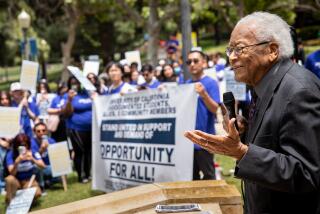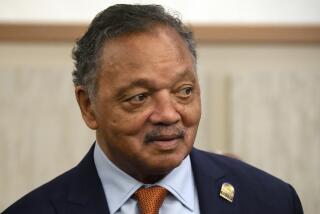PERSPECTIVES ON CIVIL RIGHTS : How Big a Role for the Middleman? : It is increasingly difficult for any one group to extend its influence across myriad public issues.
- Share via
In the 80th anniversary issue of the NAACP’s magazine, Executive Director Benjamin L. Hooks pledges that the organization will “continue to pursue truth and justice” and is “prepared to adjust to changing circumstances.” Obviously, that will be necessary if the National Assn. for the Advancement of Colored People is to maintain its claim to be “the world’s premier organization for civil rights.” But the “changing circumstances” are formidable.
Perhaps one of the more salient changes has occurred in the political arena. While the NAACP has continued to play a role in the struggle for African-American equality, it finds itself in a contemporary context with new actors and different rules. For example, data from the Joint Center for Political Studies indicate that the number of black elected officials has risen from well under 1,000 in the 1960s to well over 6,000 by the mid-1980s. The upshot of this political incorporation denotes two important changes from the civil-rights era. In a study recently published in the American Political Science Review, Prof. Lawrence Bobo of UCLA and I report that where African-Americans are politically empowered (that is, they have achieved significant representation and influence in decision-making), they are more likely to directly identify with and participate in local politics. This type of dynamic diminishes the “middleman” role that organizations such as the NAACP generally play. It might also signal an opportunity for the NAACP to channel and mold constituency preferences.
The degree to which African-Americans are empowered also alters the rules under which the political game is played. Black elected officials must respond to many constituencies both within and outside of the African-American community. Hence, it is increasingly difficult for any one group to extend its influence across myriad public issues. Substantively, the election of African-Americans to public offices creates many more points of access for a broader range of interests. If theories about the group basis of politics are accurate, we should expect a proliferation of organized interests seeking to press their claims through fresh portals to power. The increased salience of African-American professional groups is evidence of this trend.
A second dimension of political change has its roots in the nature of the contemporary socio-economic status structure. Many scholars, most notably William J. Wilson of the University of Chicago and Manning Marable of the University of Colorado, maintain that fundamental changes in the American economy have resulted in a bifurcated class structure in the African-American community.
While various authors disagree on the interpretation of this dichotomy, the political consequence is that the stage has been set for intra-group schisms on matters of public policy. A recent study I conducted along with Kenny J. Whitby of the University of South Carolina shows that while class differences among African-Americans on questions of social welfare are not nearly as great as they are for whites, there is still a noticeably great division among blacks on the issue. In addition, other studies show divisions among blacks on such issues as busing, capital punishment and abortion. The implication for organizations like the NAACP ought to be clear. Contemporary political issues and the African-American community are increasingly complex.
Resolving the tensions outlined above (vis-a-vis politics) is one of the important challenges facing the NAACP. Can it function effectively in the contemporary political milieu? Can it achieve relevance for a generation of young African-Americans facing a lifelong uphill struggle? Can it be “the world’s premier civil rights organization”?
More to Read
Sign up for Essential California
The most important California stories and recommendations in your inbox every morning.
You may occasionally receive promotional content from the Los Angeles Times.













